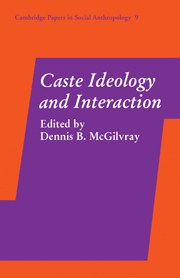2 results in Cambridge Papers in Social Anthropology

Caste Ideology and Interaction
-
- Published online:
- 04 August 2010
- Print publication:
- 02 September 1982

From Craft to Industry
- The Ethnography of Proto-Industrial Cloth Production
-
- Published online:
- 04 August 2010
- Print publication:
- 09 December 1982

